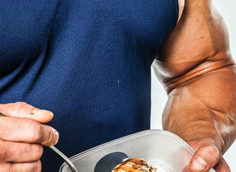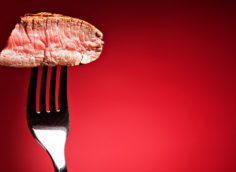Waist Blubber and Insulin Resistance
Any female can go from 45% body fat to 25% without too much trouble. Likewise, any guy can reduce his body fat from 25% to 15% with training and a decent diet plan. After that is where things can get problematic, when women try to reduce their body fat to lower than 25% and men try to break the 15% threshold.
Unfortunately, the same diet that got you to that first milestone won't likely take you to the second. Things get sticky. Fat gets all sentimental and doesn't want to leave home.
It might be coaxed into leaving some areas but it often clings to others, and more often than not the area with which it forms a special attachment is the waist.
People blame this waist tubeyness on all kinds of things including lack of sleep, poor diet, age, gender, genetics, and even cortisol, the stress hormone. While all these things likely play a part in stubborn love handles and muffin tops, they're largely symptomatic of a lack of insulin sensitivity.
Fortunately, there are several things you can do to fix your insulin resistance and specifically target the unsightly fat that makes you look like you're melting over your jeans.
Without optimal insulin sensitivity, much of that protein (and everything else) you eat gets delivered to fat storage rather than muscle, and much of the time that fat happily resides around your waist. While your instinct might be to adopt a low-carb diet, it doesn't fix the problem. What's more, a chronic low-carb diet leaves your muscle building capabilities impaired.
What you need to do instead is optimize insulin sensitivity. There are several easy dietary strategies that help you do just that:
- At the start of a meal, eat some protein and fat before your flabby lips even touch any carbohydrate. This strategy, according to research, leads to significantly lower blood sugar levels (29%, 37%, and 17% lower at 30, 60, and 120 minutes after a meal) than eating carbs first. (You should, however, flip-flop the strategy during meals around your workout and eat some carbs before eating protein.)
- Use vinegar as a salad dressing as it attenuates the glucose and insulin response from a carb meal, in addition to raising insulin sensitivity in general. Continued use can lead to an average weight loss of two pounds in four weeks. Also consider taking two tablespoons of apple cider vinegar before bed, as studies have shown that it can lower morning blood sugar by 4 to 6 percent.
- Take one teaspoon of psyllium fiber twice a day. It can lower all-day blood sugar levels by 11 percent.
- Use fish oil liberally. New studies show that not only does it rival the effects of exercise on blood sugar but, when combined with exercise, actually has a synergistic effect on blood sugar reduction. We suggest a high potency, molecularly distilled fish oil like Flameout®.
When you eat frequently, as weight lifters and bodybuilders often do, blood sugar levels are almost always elevated and your pancreas is dog tired from pumping out a near-constant flow of insulin. Research suggests that this constant flow of insulin gradually makes the body more resistant to its effects until you start to metabolically resemble a Type II diabetic. Fatness ensues, especially around the waist.
Clearly, what's needed is a diet that ensures enough protein, carbs, and calories to keep muscle growing, but that also makes the body more sensitive to insulin. Enter the 5/2 Fat-Loss Diet for Lifters. In a nutshell, you eat normally for five days out of every seven, but on the remaining two, non-consecutive days, you only eat two meals of approximately 400 calories each, 12 hours apart. The two "fasting" days should be non-weightlifting days so as not to interfere with post-workout tissue remodeling.
Additionally, on your two semi-fasted days, drink two scoops of a fast-acting protein formulation — Mag-10® is ideal — either as part of each 400-calorie meal, or 30 minutes prior to each meal to ensure that there's absolutely no possibility of muscle loss during the low-calorie periods.
This diet works because the fasting days, infrequent as they are, cause the body to become much more insulin sensitive than it would from dieting seven straight days a week. That seemingly defies logic but research shows that it works.
If followed correctly, the 5/2 Fat-Loss Diet for Lifters should allow a lifter to get steadily more ripped with each passing week without losing any muscle mass. Most importantly, however, for the love handle and muffin-top afflicted, the diet will directly address their annoying insulin problem. Learn more about the diet here.
You're no doubt lifting weights already and that's of course a good thing for the waistline challenged. Additional muscle increases glucose disposal by simply giving carbs another place to go instead of fat storage. Likewise, resistance exercise in general, in addition to most types of aerobic exercise, increase insulin sensitivity. However, there are a few types of exercise that are especially effective in targeting stubborn fat:
Complexes
A complex is just a series of movements performed with a barbell, dumbbells, or kettlebells where you perform reps of one exercise before quickly moving onto the next movement in a sequence of exercises. They're a fantastic way to burn fat and make the body more insulin sensitive in general.
Typically, you don't take your hands off the weight until the complex is finished. A basic kettlebell complex could consist of 6 reps of overhead squats, 6 conventional squats, 6 kettlebell swings, 6 bent-over rows, and 6 Romanian deadlifts done in order without stopping. After a brief rest period (a minute or so), you repeat the sequence. And then repeat it again. And again until you almost need paddles to start your spasming heart. Do them as a finisher after every workout.
Wogging and Wunning
Don't dismiss this style of exercise just because it's got a stupid name that makes you sound like you have a speech impediment. As you might guess, wogging is a combination of walking and jogging, and it's not just a remedial program for wanna-be distance runners.
Wogging actually takes advantage of new research that shows that walkers who vary their speed burn up to 20 percent more calories than walkers who maintain a steady speed. By slowing down, or even stopping, and then accelerating, you're changing the kinetic energy of your body and that requires more energy, i.e., calories.
Just walking in this halting, stop-and-go manner is effective in burning fat, but combining the concept with running instead of walking turns it into an extremely effective fat-burning regimen. As such, it should more accurately be called "wunning," but there's only so much cuteness we all can take.
Simply walk briskly for a time and then accelerate into a fast run. Once you begin to tire and your pace drops off dramatically, start walking again until you recover enough to break into another run. The distance you cover is irrelevant. Instead, set out to "wog" or "wun" for a pre-determined length of time, say, 30 minutes. Three 30-minute sessions a week will do wonders in slicing off that ugly waist blubber.
RKC Planks
Okay, RKC planks aren't going to do much to burn off muffin tops or love handles, but as long as we're building an attractive waistline in general, let's go the additional mile and "tighten up" the waist so that maybe, just maybe, it's something worth showing off.
To do an RKC plank, lie down on your stomach and support your upper body with your elbows. Squeeze your shoulders down and pull them tight to your ribs. Then tighten the glutes as hard as possible, straighten your knees, and assume the standard plank position. Now contract everything as hard as you can and focus on controlled inhalation and exhalation for the duration of the movement. Try to hold it 8 to 10 seconds. If you did it correctly, you'll collapse onto the floor like an electrocuted horse.
Remember, this isn't some worthless endurance-contest plank where you casually hold the position until your back gets mossy. They actually make your abs stronger and they might actually make the waist thinner. Do these much tougher RKC planks in-between sets of other exercises, or even during commercials when you're watching TV.
Cyanidin3-Glucoside or C3G — sold as Indigo-3G® — is naturally occurring anthocyanin. When isolated and taken in hugely concentrated form, it has powerful blood-glucose lowering properties that can go a long way in treating the fat waist caused by insulin insensitivity.
One of dozens of experiments showed that C3G caused dose-related blood glucose drops of 33% and 51%, prompting authors of the study to say how favorably it compared to powerful pharmaceutical glucose-disposal agents.
Aside from modulating insulin, it increases glucose and lipid uptake specifically in muscles, which is great news for lifters and athletes in general. It also raises adipokinectin levels while decreasing leptin levels, which lead to less overall body fat. People who use C3G can actually eat more calories – including calories from carbs – and see them partitioned to muscle instead of fat.
Take 400 to 600 milligrams before your biggest meal of the day or just before starting your intake of pre-workout nutrition. You can get it here. C3G, especially when combined with the other strategies outlined above, acts as kind of a metabolic/chemical liposuction that will strategically attack your sticky fat.





